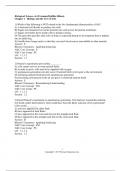Examen
Test Bank For Biological Science 6th Edition by Scott Freeman, Kim Quillin, Lizabeth Allison, Michael Black, Emily Taylor, Greg Podgorski, Jeff Carmichael
Test Bank For Biological Science 6th Edition by Scott Freeman, Kim Quillin, Lizabeth Allison, Michael Black, Emily Taylor, Greg Podgorski, Jeff Carmichael
[Montrer plus]
Publié le
2 juin 2024
Nombre de pages
1130
Écrit en
2023/2024
Type
Examen
Contient
Questions et réponses
Titre de l’ouvrage: Biological Science
Auteur(s): Scott Freeman, Kim Quillin, Lizabeth A. Allison, Michael Black, Greg Podgorski, Emily Taylor, Jeff Carmichael
Édition: 2017 ISBN: 9780321976499 Édition: Inconnu
Examen
Test Bank for Biological Science 6th Edition by Scott Freeman Lizabeth Allison A+
Examen
Test Bank Biological Science, 6th Edition (Scott Freeman, Lizabeth A. Allison ) Chapter 1-55 | All Chapters {Latest 100 % Verified Test bank}
Examen
Test Bank Biological Science, 6th Edition (Scott Freeman, Lizabeth A. Allison ) Chapter 1-55 | All Chapters {Latest 100 % Verified Test bank}
Tout pour ce livre (28)
Établissement
Tests Bank
Cours
Tests Bank
Par: saraalameri76 • 4 mois de cela
S'abonner
€16,81
Garantie de satisfaction à 100%
Disponible immédiatement après paiement
En ligne et en PDF
Tu n'es attaché à rien
1 Copyright © 2017 Pearson Education, Inc. Biological Science, 6e (Freeman/Quillin/Allison) Chapter 1 Biology and the Tree of Life 1) Which of the following is NOT related to the five fundamental characteristics of life? A) A bacterial cell divides to produce two cells. B) Sugars are transported on carrier proteins into cells across the plasma membrane. C) Sugars are broken down inside cells to produce energy. D) The gene that specifies skin color in frogs is expressed during its development from a tadpole into an adult frog. E) Giraffes have lo nger necks so that they can reach food sources unavailable to other animals. Answer: E Bloom's Taxonomy: Applying/Analyzing V&C Core Concept: E V&C Core Comp: PS LO: 1.1, 1.2 Section: 1.1 2) Pasteur's experiments proved that ________. A) cells canno t survive in swan- necked flasks B) in order to grow, cells need to be supplied with oxygen C) spontaneous generation can only occur if nutrient broth is left open to the environment D) sterilizing nutrient broth prevents spontaneous generation E) preexisti ng cells present in the air can grow in sterilized nutrient broth Answer: E Bloom's Taxonomy: Remembering/Understanding V&C Core Concept: EM V&C Core Comp: PS LO: 1.1, 1.2 Section: 1.2 3) Recall Pasteur's experiment on spontaneous generation. If he had just warmed the nutrient -




